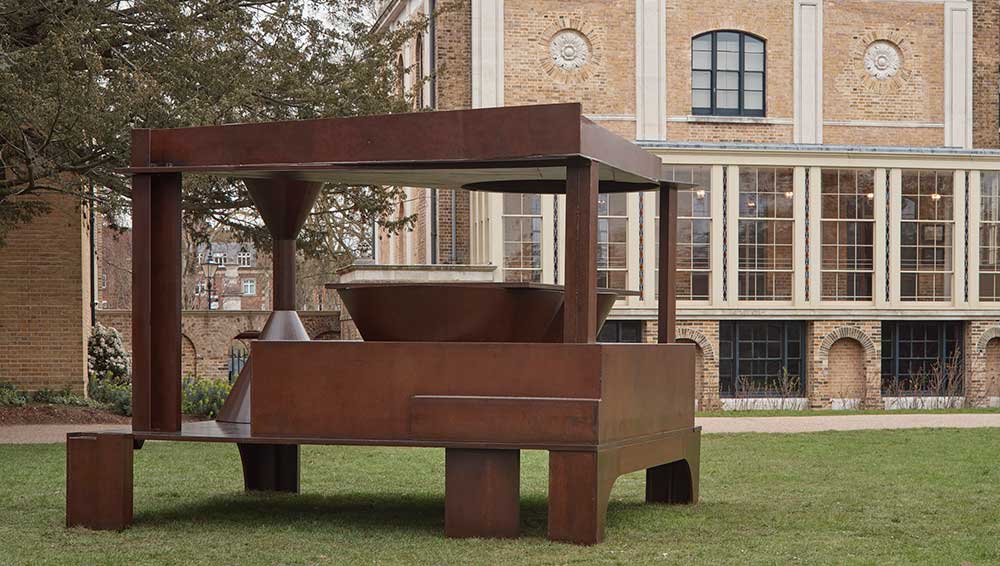
Anthony Caro. Forum, 1992-94. Installation view, The Inspiration of Architecture, Pitzhanger Manor & Gallery, London. Photo: Andy Stagg.
Pitzhanger Manor, London
9 March – 10 September 2023
by VERONICA SIMPSON
My first encounter, in the flesh as it were, with the work of Anthony Caro (1924-2013) was at the Yorkshire Sculpture Park in 2015. In the large, shed-like gallery space at the back of the park, slabs of tortured metal collided with slices of primary-coloured Perspex in the most unlikely shapes and piles. I wasn’t entirely sure what I felt about it. But I sniggered as I heard a dour Yorkshireman, exiting the gallery, say to his wife, who was waiting for him outside: “Ah, you don’t want to bother going in there, love.”
In a delightfully dated BBC documentary from the 1980s, screened at Caro’s current exhibition at Pitzhanger Manor, the cultural commentator Melvyn Bragg tells the sculptor: “People don’t know what to think about your work.” Actually, early on in Caro’s career, a few very influential people decided he was the proverbial bee’s knees. After his groundbreaking Whitechapel show in 1963, his rugged, abstract, scrapyard aesthetic – completely breaking with the organic curves and refined figuration of his one-time mentor Henry Moore, or Barbara Hepworth – was hailed by the American critic Clement Greenberg as the future of modernism. Consequently, his rusting, gazebo-like confections are often to be found among the rolling green acres of the rural super-rich.
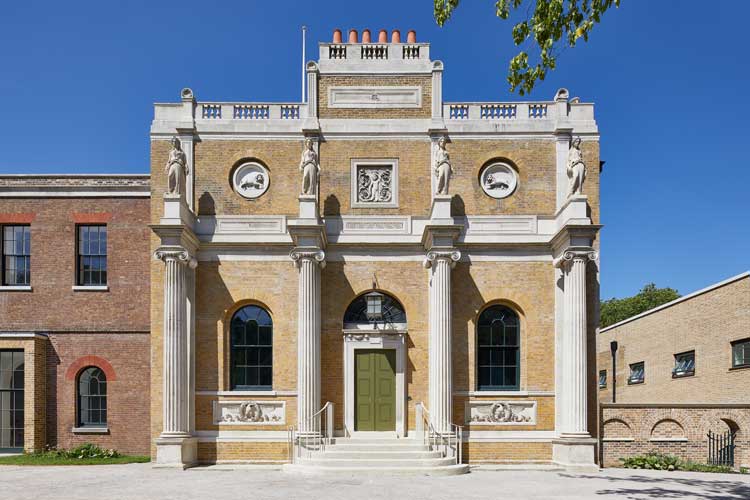
Pitzhanger Manor & Gallery, London. Photo: Andy Stagg.
While hailing him as a crucial figure in the evolution of contemporary sculpture, today’s critics are divided even in their own opinions, loving some of the work as fervently as they hate other pieces. But when I heard that he would be showing at Pitzhanger Manor, the exquisite West London venue that was once the country home of the UK’s foremost Georgian architect, Sir John Soane, I thought that this was an aesthetic collision I needed to witness. Would Caro’s work sing out against the strong character and harmony of the architecture, or scream?
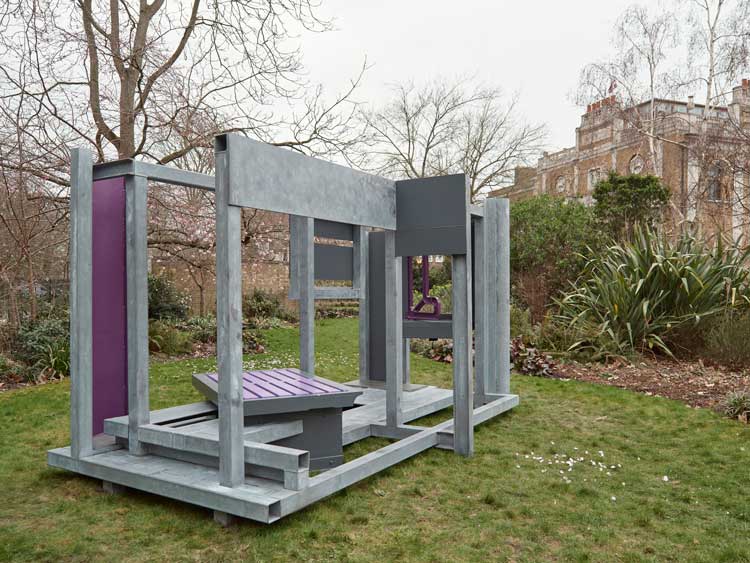
Anthony Caro. Magnolia Passage, 2005-06. Installation view, The Inspiration of Architecture, Pitzhanger Manor & Gallery, London. Photo: Andy Stagg.
Well, it’s a bit of both. I found myself fascinated and repelled by Magnolia Passage (2005-06), a galvanised-steel structure that sits on the front lawn. This is Caro’s idea of “sculpitecture” writ large, an idea as clunky as its name suggests. It evokes but denies habitation, with its lean frame of steel-box beams and rigid “furniture” arranged to prevent any sense of shelter or perch. And the violent purple paint applied to two sections screeches too loudly in this natural setting, a note of “fun” that falls badly flat.
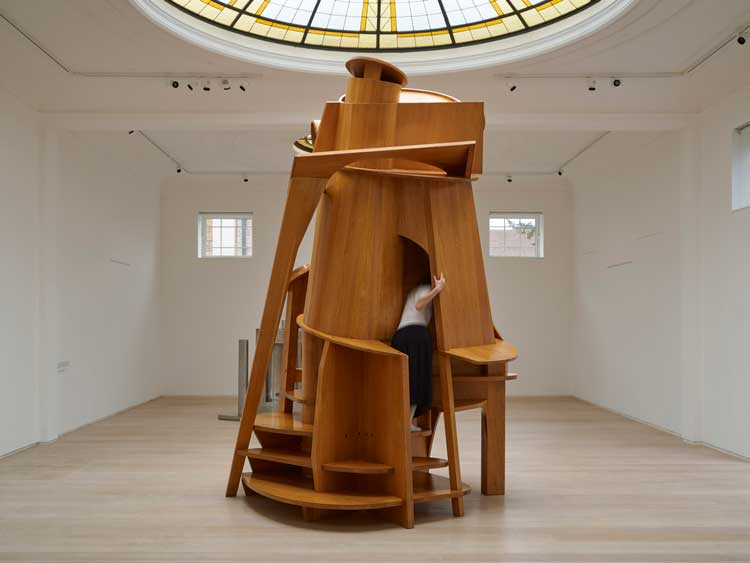
Anthony Caro. Child’s Tower Room, 1983-84. Installation view, The Inspiration of Architecture, Pitzhanger Manor & Gallery, London. Photo: Andy Stagg.
Far more welcoming and winsome is Child’s Tower Room (1983-84), placed so as to strike the eye and the senses with its warm wood surfaces the minute you enter the gallery foyer. A tall, rocket-like thing, the steps curving into its interior invite exploration – and, delightfully, the exhibition allows it, albeit with shoes and socks removed to avoid slippage. It is the central sculpture of three large works, placed with plenty of room for circulation and investigation in Pitzhanger’s contemporary gallery extension, which incorporates two of Soane’s original, yellow-tinted skylights.
That fabulous, Soanean yellow harmonises with the tinted Perspex of Autumn Rhapsody (2011) in the far corner, and almost redeems this clunky combination of what looks like a piece of production-line factory furniture being mounted by some brightly coloured boutique shelving. Over to the left is The Eye Knows (2013), a brushed-steel confection whose simple curves, planes and spouts reminded my gallery companion of the milking stalls in the dairy where her grandma used to take her to collect fresh milk. Comprising an upended industrial sink and slices of steel with clear acrylic, it has a meditative power in its dialogue between machine-made and hand-sculpted, teasing out associations serious and silly, functional and fun.
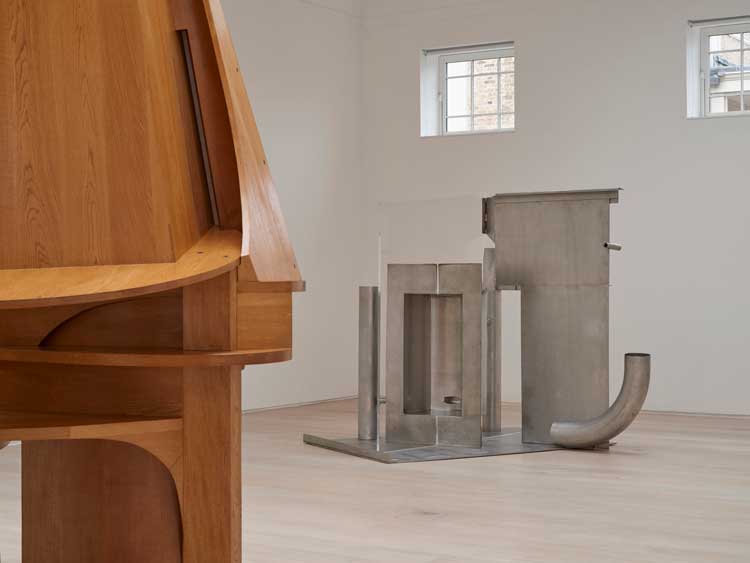
Anthony Caro. The Eye Knows, 2013. Installation view, The Inspiration of Architecture, Pitzhanger Manor & Gallery, London. Photo: Andy Stagg.
The Guardian art critic Jonathan Jones once described Caro as “an artist caught between his ambition to be a great modernist, and his technician’s delight in colour and form that makes him put frills everywhere. Except that the frills are Perspex, wood and steel.” I found The Eye Knows a relatively restrained demonstration of Jones’s theory: for the most part, the work balances nicely the clash of curved with angular geometries, the mix of industrial and sculptural, but then there is an annoying “frill” of folded steel along one edge; its presence a pointless flourish.
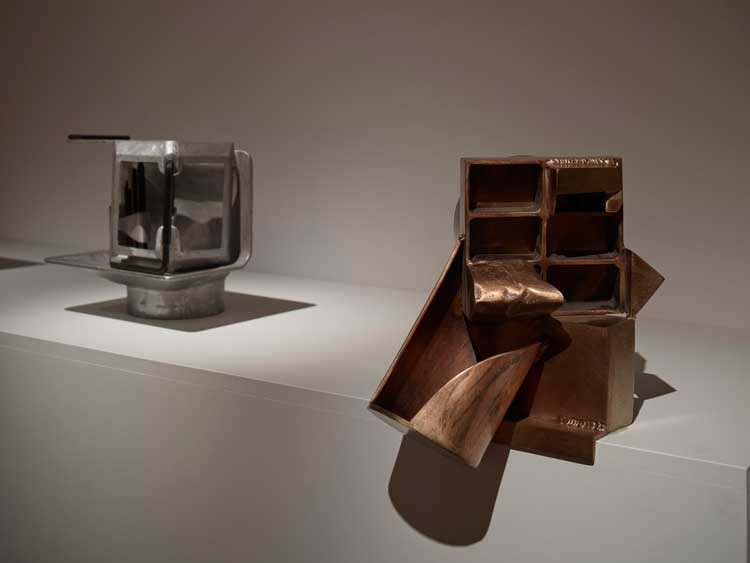
Anthony Caro: The Inspiration of Architecture, Pitzhanger Manor & Gallery, London. Photo: Andy Stagg.
In the north gallery, a more intimate space, there are several smaller “table works”. These, being simpler perhaps, are more successful in their transformation of solid, lumpen material into something suggestive of movement and grace. One cluster of metal curves and lines somehow evokes books and the riffling movement of pages blowing in a breeze. Another, Table Piece, Dwelling (1996-97), is the closest to a representation of habitable space, with something of the agricultural barn about its rusted envelope, housing curves and ramps and chunks suggestive of a table, a chair, a sofa. It is almost restful to contemplate. Reliquary House (2011), a concrete hut with steel sections protruding from its shadowy insides, is tomb-like but strangely appealing. Discussing this piece with Paul Moorhouse, curator and CEO of the Anthony Caro Centre, he tells me: “What you do when you’re looking at that is to imagine what’s inside it. There’s almost a mortuary element … The form contributes to the feeling.”
Moorhouse, necessarily a great advocate for Caro’s work and its clear dialogue with architecture, says he couldn’t resist the opportunity of placing his sculptures in Soane’s building. “I was struck by the home of this great neoclassical architect. It was replete with everything – the passages, the sequence of spaces, the walls, the scale, the decorative elements, and also the use of glass and coloured glass and light. And this was the language of Caro. They were speaking in the same tongue. He was using sculpture in an architectural context. It was a no-brainer, this was going to be my opportunity to revisit Caro’s relationship to architecture.” The particular part of Caro’s evolution that Moorhouse wishes to present is the work that followed on from a visit to Greece in the 1980s: previously, Caro had resisted the idea of encountering classical architecture at its source. Moorhouse says: “He’d put it off. But, suddenly, he was ready to take it on. He saw the temples, the relationship of sculpture and architecture together. He was blown away by it. It relaunched his interest in architecture as a form of sculpture.”
Caro once described architecture as “perhaps the purest abstract visual form”. And when Moorhouse repeats this phrase to me, I find myself wanting to take issue. In my view, the finest architecture delivers only when the skill in visualising abstract forms is wedded to an understanding of what it takes to create inviting and habitable space. Architecture is anything but abstract. It’s habitat. Where Caro’s work evokes the space and memory and feeling of architecture, but simply as an assortment of components, it becomes less than the sum of its parts, not more. That is how I feel about Door (2005), a galvanised-steel work that sits in the outside courtyard between the main gallery and manor house. It is clearly not a door, though it has door-like elements, as if the hefty doorframe of a nuclear bunker had been transported to this spot of grace, curves, lightness, texture and richness. I’m not sure that is any kind of enhancement.
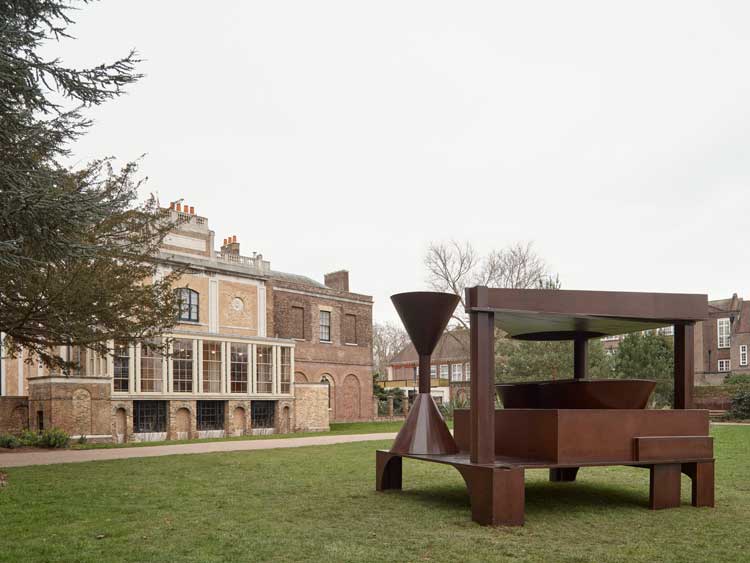
Anthony Caro. Forum, 1992-94. Installation view, The Inspiration of Architecture, Pitzhanger Manor & Gallery, London. Photo: Andy Stagg.
Where that investigation is at its most potent, I find, is in the smaller works. And perhaps in the third major outdoor work, Forum (1992-94), a rusted but handsome piece of sculpitecture that sits in the grounds beyond the gallery, overlooking the park, looking very much at home.
It is always difficult to appraise the work of pioneers decades down the line, long after the initial shock and shifting perspectives engendered by their work have filtered into the mainstream. If there were no Caro, there might be no Rachel Whiteread, no Richard Long, no Mike Nelson.
But I return to a comment Caro makes in response to Bragg’s question about how to respond to his work. He says: “Just keep standing in front of lots of art … as you continue to look a lot at art, in the end your eye is going to get honed.” Yes, but that does rather put the onus on the one doing the looking, rather than the creator of the work.